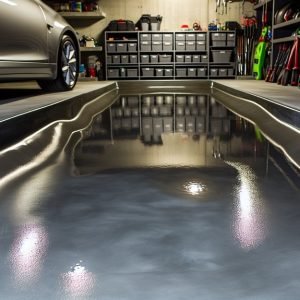Last Updated on January 28, 2025 by teamobn
With growing concerns around climate change and sustainability, many homeowners today are taking steps to reduce their carbon footprint and adopt measures that will benefit the environment. From energy-efficient lighting and low-flow water appliances, various eco-friendly upgrades can be implemented that allow homeowners to save money while positively contributing to the planet.
Contents
Eco-Friendly Garage Upgrades You’ll Love
When making green changes around the home, one area that is often overlooked is the garage. Whether it’s a space to house vehicles and DIY tools or it’s been converted into a livable space for tenants or guests, with a few modifications a garage can become a part of the home that benefits the environment as well as the people that live there. In this article, we’ll explore various eco-friendly garage ideas to help homeowners lower their energy bills as well as their carbon footprint.
Floor Maintenance
The condition of a garage floor can have a significant impact on its energy efficiency. This includes the material it is made from and the way it has been installed. For example, concrete flooring in garages is often prone to cracks and wear over time which can cause drafts to enter. These drafts will lower the energy efficiency of the garage and potentially impact other areas of the home causing greater reliance on HVAC systems for heating and cooling purposes.
To prevent air from leaking or entering the garage, it is important to seal any cracks in the floor using eco-friendly coating materials such as polyaspartic coatings, epoxy coatings, or water-based concrete sealers. As these coating materials often contain zero volatile organic compounds (VOCs) they are a less toxic option compared to other sealants on the market, making them an environmentally-friendly choice for homeowners looking to enhance the energy efficiency of their garage floor.
Inspect Garage Windows
The energy efficiency of a garage can be greatly impacted by the condition of its windows. As old or damaged windows are a common source of drafts and heat loss, replacing or repairing them can improve the insulation and overall energy efficiency of your garage.
Repairing or replacing damaged weather-stripping and caulking seals around existing garage windows can help prevent heat loss and cool air from entering your garage. Alternatively, replacing old windows with energy-efficient models that have double or triple glazing can provide better insulation for the space, helping homeowners lower their energy bills and their overall carbon footprint. 
Cap Door Frames With Aluminum
Garage door frames can benefit from aluminum capping, as it helps them become more efficient at insulating the interior space and protecting the door frame from the elements. This capping will help to keep a stable temperature within a garage as it eliminates any gaps or cracks in the door frame, preventing warm air from escaping in the winter and keeping cool air inside in the summer.
This reduces the need for heating and cooling throughout the year, resulting in lower energy consumption and less expense. This is especially beneficial if completed during the garage door installation process.
Insulate Access Doors
It is also important to ensure any interior doors that provide access to the garage are also adequately insulated. Any gaps or cracks in these doors can create drafts and heat loss from within a property, leading to increased energy consumption and higher heating or cooling costs. Proper insulation of interior access doors can help to avoid this problem, by preventing air from the garage from entering the home.
Weatherstripping can be added around the edges of interior doors to create an airtight seal that prevents drafts and air from leaking from the home. Foam panels and draft guards can also be used to insulate the doors to ensure they are properly sealed and insulated, improving the energy efficiency and comfort of a home.
Install Motion Detectors
In addition to energy-efficient lighting in a garage, motion detectors can also be fitted to ensure lighting is only in use when someone is in the room. By reducing the amount of time lights are left on, motion detectors can contribute to a more eco-friendly garage, helping to lower overall energy consumption and minimize the carbon footprint of those who live there.
Use Sustainable Materials
The Environmental Protection Agency (EPA) estimated that 600 million tons of construction and demolition debris were generated in the United States in 2018(latest available statistics). Rather than using newly manufactured building materials to renovate or repair a garage, reclaimed or recycled building materials can offer a more sustainable and eco-friendly choice. This will lower the amount of waste that ends up on landfill sites and pollutes the environment. The bonus is that you will also save on your material costs.
Sustainable building materials can include things like recycled asphalt shingles for roofing, garage doors made from recycled wood or steel, or reclaimed wood for flooring. By contributing to a circular economy, homeowners also avoid the need for additional manufacturing and transportation, which can significantly reduce carbon emissions and the consumption of energy and natural resources.
Check Appliances
Many people use their garage as a room to house electrical appliances like laundry machines, refrigerators and freezers. Regularly checking these appliances for leaks or clogs can ensure they are working optimally and at their most energy-efficient.
For instance, door seals on washing machines or clothes dryers should be inspected for any cracks or gaps that could allow cold air to escape, causing these appliances to work harder to maintain their desired temperature and increase their energy consumption. Similarly, clogged filters for vents can cause appliances to reduce their efficiency and consume more energy than is necessary.
Homeowners may also consider upgrading their appliances to energy-efficient models which are designed to work more efficiently and can reduce energy bills. With features such as low power consumption, improved insulation and low water consumption, energy-efficient appliances offer an eco-friendly way to carry out tasks with minimal impact on the environment.
In addition to the regular inspection and maintenance of appliances in the garage, unplugging any appliances or devices that are not in use can help homeowners reduce the energy consumption of their garage.
The Takeaway
As we’ve seen, transforming your garage into an eco-friendly space isn’t just about making green upgrades—it’s about creating a more energy-efficient home that benefits both your wallet and the planet. From sealing cracks to installing energy-efficient appliances, every step you take makes a difference. Not only will these changes help reduce your carbon footprint, but they’ll also lower your energy bills and contribute to a healthier environment.
So, why wait? Start making eco-friendly garage upgrades today and join the growing movement towards sustainable living. Whether you begin with small steps like replacing weatherstripping or take on larger projects like installing solar-powered lighting, each improvement counts.
Let’s build a greener future—one garage at a time. Ready to make your garage a model of sustainability? Start now!






